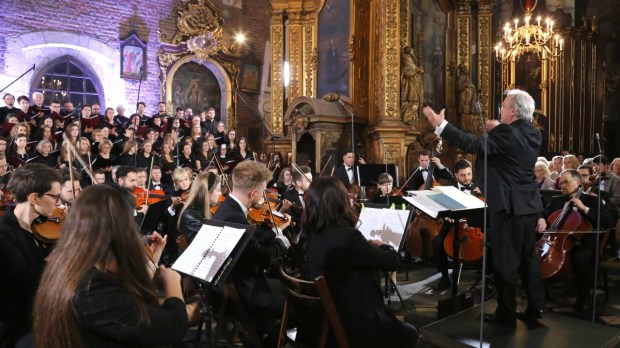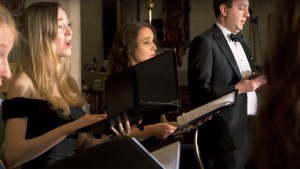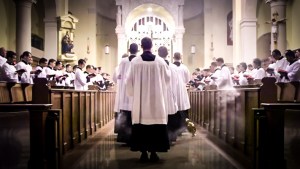If beauty is an attribute of God, there’s no doubt that listening to magnificent musical compositions leads us to him. And it also gives us hope. Especially when they are written for the departed!
In the Roman Rite’s Mass for the Dead, the “introit” (a kind of entrance song) begins with the words, “Eternal rest give unto them, O Lord.” In Latin, the first word is “rest,” requiem. Consequently, this word has long been used to describe the entire Mass, and then also the musical compositions written for the texts sung during it.
Numerous composers have written the parts of the Mass—introit, Kyrie, gradual, tract, sequence (Dies irae), offertory, Sanctus, Agnus Dei, communion chant, responsory for absolution in church, Subvenite responsory at the exit of the body from the church, absolution on the way to the cemetery, and In Paradisum before the tomb… Other musicians have also written non-liturgical concert pieces, called requiem by extension. Here is an admittedly subjective selection of some of the best settings.
1
The original: the Gregorian Mass
Gregorian chant, characteristic of the Latin liturgy, has its roots in the monastic life of the early Middle Ages. Most of the pieces of the Mass for the Dead are still usable in the liturgy as reformed after the Second Vatican Council, although it now includes an Alleluia and certain responsories have been removed, notably at the end of the Mass.
2
The precursor: Johannes Ockeghem’s Requiem
At the end of the 15th century, Flemish-born composer Johannes Ockeghem (1420-1497) was the first to write a polyphonic requiem, featuring medieval tonalities less familiar to contemporary ears. Actually, he was certainly not the first, but his score is the earliest to have come down to us. He was the maestro di cappella for French kings Charles VII, Louis XI, and Charles VIII. His requiem was probably written for the death of one of the first two, in 1461 or 1483.
3
The most regal: Eustache du Caurroy’s Requiem
Like the previous composer, Eustache du Caurroy (1549-1609) was the court composer of the king of France starting in 1595. He composed this requiem for the Mass for the death of Henry IV in 1610. The score was used for the king’s descendants, buried in the royal basilica of Saint-Denis.
4
The most baroque: Jean Gilles’ Requiem
Jean Gilles (1668-1705), who died at the age of 37, is a little-known southern Baroque composer. Master of music at Toulouse Cathedral, he composed a requiem for the city’s notables, which was never paid for by its sponsors. Jean Gilles decided to keep it for his own funeral. It was also performed at the funerals of fellow composer Jean-Philippe Rameau and King Louis XV.
5
The most classic(al): Mozart’s Requiem
The requiem by Wolfgang Amadeus Mozart (1756-1791) is undoubtedly the most widely performed. The Austrian composed it in the year of his death, but was unable to complete it. This was done at the request of his wife Constance by three of the master’s pupils.
6
The longest: Brahms’ Requiem
Johannes Brahms (1833-1897) didn’t set out to produce a liturgical work when he composed his “German Requiem” in 1868. A score for soloists, choir and orchestra, it is inspired as much by the Mass of the Dead as by texts from sacred scripture (in Luther’s Bible) to make it more ecumenical. Particularly long, it lasts between 70 and 80 minutes.
7
The most Romantic: Verdi’s Requiem
Giuseppe Verdi (1813-1901), an emblematic figure of the Risorgimento associated with the birth of the Italian nation, is also the author of a well-known requiem imbued with Romantic characteristics. First performed at St. Mark’s in Milan in 1874, it was not the only requiem he composed, but the first had given rise to a quarrel with other musicians.
8
The most grandiose: Fauré’s Requiem
Gabriel Fauré (1845-1924), titular organist at the Madeleine church in Paris, wrote a requiem considered his masterpiece, composed in 1887. At the age of 42, the musician adapted the liturgy, omitting the Dies irae sequence. Performed in 1893 for the centenary of King Louis XVI’s death, it was also adapted for symphonic playing by Fauré himself.
9
The most Parisian: Maurice Duruflé’s Requiem
Maurice Duruflé (1902-1986) was assisting Louis Vierne, titular organist at Notre Dame Cathedral in Paris, when the latter died suddenly. Living from 1930 onwards in the Place du Panthéon with his wife Marie-Madeleine, also an organist, Duruflé created a requiem in 1947 (heavily influenced by the Gregorian Mass) of which there are three orchestrations.
10
The most ecumenical: the Requiem of Reconciliation
For the 50th anniversary of the end of the Second World War, in 1995, the International Academy of Stuttgart commissioned a very special requiem: the Catholic Mass for the Dead was cut into 14 pieces, entrusted to 14 composers representing 14 nations involved in the conflict. The result is… ecumenical.



